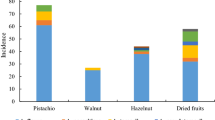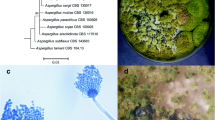Abstract
The present study reports on the natural mycobiota occurring in Chinese peanuts marketed in Algiers, paying special attention to the incidence of Aspergillus section Flavi species that are potential producers of aflatoxins. The mean value counts of fungi ranged from 155 to 577 CFU/g dry matter (DM) and the predominant fungi were different species of the genus Penicillium (83.81–93.85 %) and Aspergillus belonging to section Flavi (2.73–73.96 %). Results indicated that 82 isolates (100 %) were aflatoxigenic. The Aspergillus section Flavi strains revealed that 65 isolates (79.27 %) were highly aflatoxigenic, producing four kinds of aflatoxins [AFB1 (0.846–3.330 μg/g), AFB2 (0.005–0.007 μg/g), AFG1 (0.008–1.595 μg/g), and AFG2 (0.005–0.010 μg/g)], whereas 17 isolates (20.73 %) synthetized low levels of one or two aflatoxins (AFB1 and AFG2). Aflatoxin production was also screened on Coconut Agar Medium (CAM), and the results were consistent with the HPLC analysis. Based on the combination of mycotoxins produced, five Aspergillus section Flavi chemotypes were established. Sclerotia production expressed a correlation to aflatoxigenicity. The total aflatoxins were detected in four analyzed samples at levels ranging from 0.71 to 25.50 μg/kg. Furthermore, the amplicons corresponding to the ITS1-5.8 S-ITS2 rDNA of six representative strains showed that four strains belonged to Aspergillus flavus, one to A. minisclerotigenes, and one to A. caelatus. The results obtained indicate that there is a possible risk factor posed by aflatoxins contamination of peanuts marketed in Algiers.
Similar content being viewed by others
References
Abbas HK, Weaver MA, Zablotowicz RM, Horn BW, Shier WT (2005) Relationships between aflatoxin production and sclerotia formation among isolates of Aspergillus Section Flavi from the Mississippi Delta. Eur J Plant Pathol 112:283–287
Barros G, Torres A, Palacio G, Chulze S (2003) Aspergillus species from section Flavi isolated from soil at planting and harvest time in peanut-growing regions of Argentina. J Sci Food Agric 83:1303–1307
Bayman P, Cotty PJ (1993) Genetic diversity in Aspergillus flavus: association with aflatoxin production and morphology. Can J Bot 71:23–34
Bennett JW (1987) Mycotoxins, mycotoxicoses, mycotoxicology. Mycopathologia 100:3–5
Bennett JW, Klich M (2003) Mycotoxins. Clin Microbiol Rev 16:497–516
Berthier J, Valla G (1998) Moisissures - mycotoxines et aliments: du risque à la prévention. Rev Med Vet 149:479–492
Blankenship PD, Cole RJ, Sanders TH, Hill RA (1984) Effect of geocarposphere temperature on preharvest colonization of drought stressed peanut by Aspergillus flavus and subsequent aflatoxin contamination. Mycopathologia 85:69–74
Bourais I, Amine A (2006) Aflatoxines toxiques redoutables dans nos aliments. Les techniques de laboratoire. No. 0/2006. p. 4–8
Bragulat MR, Abarca ML, Cabanes FJ (2001) An easy screening method for fungi producing ochratoxin A in pure culture. Int J Food Microbiol 71:139–144
Cahagnier B (1998) Moisissures des aliments peu hydratés. Lavoisier Tec & Doc, Paris
CAMAG (1997). Determination of aflatoxins B1, B2, G1 and G2 in foodstuffs. CAMAG, Application notes, BIBLIOGRAPHY SERVICE (CBS). Thin-layer chromatography. 79, p. 10
Castegnaro M, Wild CP (1995) IARC activities in mycotoxin research. In Nat Toxins 3:327–331
Chang PK, Bennett JW, Cotty PJ (2001) Association of aflatoxin biosynthesis and sclerotial development in Aspergillus parasiticus. Mycopathologia 153:41–48
Cole G, Kendrick B (1981) Biology of conidial fungi. Academic, London
Cotty PJ (1989) Virulence and cultural characteristics of two Aspergillus flavus strains pathogenic on cotton. Phytopathology 79:808–814
Cotty PJ (1997) Aflatoxin-producing potential of communities of Aspergillus section Flavi from cotton producing areas in the United States. Mycol Res 101:698–704
Davis ND, Iyer SK, Diener UL (1987) Improved method of screening for aflatoxin with a coconut agar medium. Appl Environ Microbiol 53:1593–1595
Dehghan P, Zaini F, Mahmoudi M, Jebali A, Kordbacheh P, Rezaei S (2008) Aflatoxin and sclerotia production in clinical isolates of Aspergillus flavus group. Iranian J Publ Health 37:41–50
D’Mello JPF, McDonald AMC (1997) Mycotoxins. Anim Feed Sci Technol 69:155–166
Dorner JW, Cole RJ (2002) Effect of application of nontoxigenic strain of Aspergillus flavus and A. parasiticus on subsequent aflatoxin contamination of peanut in storage. J Stored Prod Res 38:329–339
Egel DS, Cotty PJ, Ellias KS (1994) Relationships among isolates of Aspergillus sect. Flavi that vary in aflatoxin production. Phytopathology 84:906–912
Ellis WO, Smith PJ, Simpson BK, Khanizadeh S, Oldham JH (1993) Control of growth and aflatoxin production of Aspergillus flavus under modified atmosphere packaging conditions. Food Microbiol 10:9–21
European Commission (2006) Final report of a mission carried out in China, in order to assess the felicities and measures in place for the control of aflatoxin contamination in peanuts intended for export into the UE. Report DG (SANCO)/8126/2006
European Union (UE) (2005) Commission Regulation (EC) N°. 856/2005. Official Journal of the European Union 48 (6 June 2005), 3–8
Felsentein J (1981) Evolutionary trees from DNA sequences: a maximum likelihood approach. J Mol Evol 17:368–376
Fente CA, Ordaz JJ, Vazquez BI, Franco CM, Cepeda A (2001) New additive for culture media for rapid identification of aflatoxin-producing Aspergillus strains. Appl Environ Microbiol 67:4858–4862
Frisvad JC, Samson RA, Smedsgaard J (2004) Emericella astellata, a new producer of aflatoxin B1, B2 and sterigmatocystin. Lett Appl Microbiol 38:440–445
Gabal MA, Hegazi SA, Hassanin N (1994) Aflatoxin production by Aspergillus flavus field isolates. Vet Hum Toxicol 36:519–521
Geiser DM, Dorner JW, Horn BW, Taylor JW (2000) The phylogenetics of mycotoxin and sclerotium production in Aspergillus flavus and Aspergillus oryzea. Fungal Genet Biol 31:169–179
Giorni P, Magan N, Pietri A, Bertuzzi T, Battilani P (2007) Studies of Aspergillus section Flavi isolated from maize in northen Italy. Int J Food Microbiol 113:330–338
Goncalez E, Nogueira JH, Fonseca H, Felicio JD, Pino FA, Correa B (2008) Mycobiota and mycotoxins in Brazilian peanut kernels from sowing to harvest. Int J Food Microbiol 123:184–190
Hanlin RT (1969) Fungi in developing peanut fruits. Mycopath Mycol Appl 38:93–100
Hill RA, Lacey J (1983) Factors determining the microflora of stored barley grain. Ann App Biol 102:467–483
Horn BW (2006) Relationship between soil densities of Aspergillus species and colonization of wounded peanut seeds. Can J Microbiol 52:951–960
Horn BW, Dorner JW (1998) Soil populations of Aspergillus species from section Flavi along a transect through peanut-growing regions of the United States. Mycologia 90:767–776
Horn BW, Greene RL, Dorner JW (1995) Effect of corn and peanut cultivation on soil populations of Aspergillus flavus and A. parasiticus in southwestern Georgia. Appl Environ Microbiol 61:2472–2475
Horn BW, Greene RL, Sorensen RB, Blankenship PD, Dorner JW (2001) Conidial movement of nontoxigenic Aspergillus flavus and Aspergillus parasiticus in peanut fields following application to soil. Mycopathologia 151:81–92
IARC (1982) The evaluation of the carcinogenic risk of chemical to humans, IARC Monograph Supplement, vol 4, 4th edn. International Agency for Research on Cancer, Lyon
Jukes TH, Cantor CR (1969) Evolution of Protein Molecules. In: Murno HN (ed). Academic, New York, pp 21–132
Klich MA (1998) Soil fungi of some low-altitude desert cotton fields and ability of their extracts to inhibit Aspergillus flavus. Mycopathologia 142:97–100
Klich MA (2007) Environmental and developmental factors influencing aflatoxin production by Aspergillus flavus and Aspergillus parasiticus. Mycoscience 48:71–80
Kozakiewicz Z (1989) Aspergillus species on stored products. Mycological Papers, vol 161. CAB International, Wallingford
Liu D, Coloe S, Baird R, Pedersen J (2000) Rapid Mini-Preparation of Fungal DNA for PCR. J Clin Microbiol 38:471
Luchese RH, Harrigan WF (1993) Biosynthesis of aflatoxin – the role of nutritional factors. J Appl Bacteriol 74:5–14
Mishra HN, Das C (2003) A review on biological control and metabolism of aflatoxin. Crit Rev Food Sci Nutr 43:245–264
Molina M, Gianuzzi L (2002) Modelling of aflatoxin production by Aspergillus parasiticus in a solid medium at different temperatures, pH and propionic acid concentrations. Food Res Int 35:585–594
Moss MO (1996) Mode of formation of ochratoxin A. Food Addit Contam 135:5–9
Nicholson P, Chandler E, Simpson DR, Thomsett M, WILSON A (2003) Molecular methods for species and chemotype detection of toxigenic fungi. Asp App Bio 68:11–20
Novas MV, Cabral D (2002) Association of mycotoxin and sclerotia production with compatibility groups in Aspergillus flavus from peanut in Argentina. Plant Dis 86:215–219
Okano K, Tomita T, Kumeda Y, Matsumaru K, Ichinoe M (2008) Aflatoxin B and G contamination in imported peanuts [Arachis hypogaea] and Aspergillus section Flavi of the causing fungi. Mycotoxins. AGRIS Categories. Food Contamin Toxicol 58:107–114
Payne GA, Brown MP (1998) Genetics and Physiology of aflatoxin biosynthesis. Annu Rev Phytopath 36:329–362
Pildain MB, Vaamonde G, Cabral D (2004) Analysis of population structure of Aspergillus flavus from peanut based on vegetative compatibility, geographic origin, mycotoxin and sclerotia production. Int J Food Microbiol 93:31–40
Pildain MB, Frisvad JC, Vaamonde G, Cabral D, Varga J, Samson RA (2008) Two novel aflatoxin producing Aspergillus species from Argentinean peanuts. Int J Sysyt Evol Microbiol 58:725–735
Pitt JI, Hocking AD (1997) Fungi and food Spoilage, 2nd edn. Blackie, London
Pitt JI, Hocking AD, Bhudhasamai K, Miscamble BF, Wheeler KA, Tanboon-Ek P (1993) The normal mycoflora of commodities from Thailand. 1. Nuts and oilseeds. Int J Food Microbiol 20:211–226
Raper KB, Fennell DI (1977) The genus Aspergillus. Krieger, Malabar
Razzaghi-Abyaneh M, Shams-Ghahf Arokhi M, Allameh A, Kazeroon-Shiri A, Ranjbar-Bahadori S, Mirzahoseini H, Rezaee MB (2006) A survey on distribution of Aspergillus section Flavi in corn field soils in Iran: Population patterns based on aflatoxins, cyclopiazonic acid and sclerotia production. Mycopathologia 161:183–192
Reboux G (2006) Mycotoxines: effets sur la santé et interactions avec d’autres composants organiques. Rev Fr Allergol 46:208–212
Riba A, Bouras N, Mokrane S, Mathieu F, Lebrihi A, Sabaou N (2010) Aspergillus section Flavi and aflatoxins in Algerian wheat and derived products. Food Chem Toxicol 48:2772–2777
Saitou N, Nei M (1987) The neighbor-joining method: a new method for reconstructing phylogenetic trees. Mol Biol Evol 4:406–425
Sultan Y, Magan N (2010) Mycotoxigenic fungi in peanuts from different geographic regions of Egypt. Mycotoxin Res 26:133–140
Tamura K, Dudley J, Nei M, Kumar S (2007) MEGA4: Molecular Evolutionary Genetics Analysis (MEGA) software version 4.0. Mol Biol Evol 24:1596–1599
Thompson JD, Higgins DG, Gibson TJ (1994) CLUSTAL W: improving the sensitivity of progressive multiple sequence alignment through sequence weighting, position-specific gap penalties and weight matrix choice. Nucleic Acids Res 22:4673–80
Turner NW, Subrahmanyam S, Piletsky SA (2009) Analytical methods for determination of mycotoxins: a review. Anal Chim Acta 632:168–180
Vaamonde G, Patriarca A, Fernandez Pinto V, Comerio R, Degrossi C (2003) Variability of aflatoxin and cyclopiazonic acid production by Aspergillus section Flavi from different substrates in Argentina. Int J Food Microbiol 88:79–84
Varga J, Frisvad JC, Samson RA (2009) A reappraisal of fungi producing aflatoxins. World Mycotoxin J 2:263–277
White TJ, Bruns T, Lee S, Taylor J (1990) Amplification and direct sequencing of fungal ribosomal RNA genes for phylogenetics. In: Innis MA, Gelfand DH, Sninsky JJ, White TJ (eds) PCR Protocols: a guide to methods and Applications. Academic, San Diego, pp 315–322
Williams JH, Phillips TD, Jolly PE, Stiles JK, Jolly CM, Aggarwal D (2004) Human aflatoxicosis in developing countries: a review of toxicology, exposure, potential health consequences, and interventions. Am J Clin Nutr 80:1106–1122
Yu J, Bathnagar D, Cleveland TE (2004) Completed sequence of aflatoxin pathway gene cluster in Aspergillus parasiticus. FEBS Lett 564:126–130
Zehrer W (1996) Promotion de la Protection Intégrée des Cultures et des Denrées Stockées à Madagascar. Recueil des exposés lors du Symposium tenu à Toliara du 7 au 11 Octobre 1996. Service de la Surveillance Phytosanitaire du Territoire National Direction de la Protection des Végétaux. BP 1042 – Nanisana. 101 Antananarivo. Madagascar
Zhang Z, Schwartz S, Wagner L, Miller W (2000) A greedy algorithm for aligning DNA sequences. J Comput Biol 7:203–14
Author information
Authors and Affiliations
Corresponding author
Rights and permissions
About this article
Cite this article
Guezlane-Tebibel, N., Bouras, N., Mokrane, S. et al. Aflatoxigenic strains of Aspergillus section Flavi isolated from marketed peanuts (Arachis hypogaea) in Algiers (Algeria). Ann Microbiol 63, 295–305 (2013). https://doi.org/10.1007/s13213-012-0473-0
Received:
Accepted:
Published:
Issue Date:
DOI: https://doi.org/10.1007/s13213-012-0473-0




